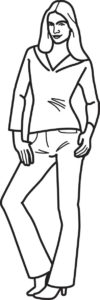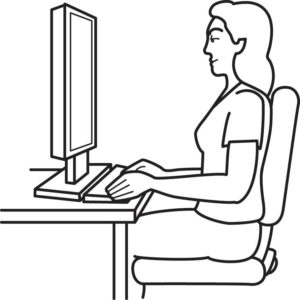

Striking a Pose
Mainstream Posture
The final review of mainstream posture instruction will be medlineplus.gov which is at, or near the top of the list when you google “proper posture”. You should have an idea now of the difference between Type 1 and Type 2 posture. If not the blog will be consistently reminding you of the difference.
Quotes from the MedlinePlus’ website:
Guide to Good Posture
Summary
Good posture is about more than standing up straight so you can look your best. It is an important part of your long-term health. Making sure that you hold your body the right way, whether you are moving or still, can prevent pain, injuries, and other health problems
What is “standing up straight”?. What is “too straight”? What is “not straight enough”? Sentence is unclear and has no reference points for guidance. The word “hold” implies a “position” or “pose” that should be maintained. Summary implies “standing up straight” is when you look your best.
More quotes from the MedlinePlus website:
How can I improve my posture when sitting?
Many Americans spend a lot of their time sitting – either at work, at school, or at home. It is important to sit properly, and to take frequent breaks:
- Switch sitting positions often
- Take brief walks around your office or home
- Gently stretch your muscles every so often to help relieve muscle tension
- Don’t cross your legs; keep your feet on the floor, with your ankles in front of your knees

The Position To Maintain
- Make sure that your feet touch the floor, or if that’s not possible, use a footrest
- Relax your shoulders; they should not be rounded or pulled backwards
- Keep your elbows in close to your body. They should be bent between 90 and 120 degrees.
- Make sure that your back is fully supported. Use a back pillow or other back support if your chair does not have a backrest that can support your lower back’s curve.
- Make sure that your thighs and hips are supported. You should have a well-padded seat, and your thighs and hips should be parallel to the floor.
The first three points indicate the position MedlinePlus encourages should not be maintained for long periods. This is good. The next six points, except for relaxing the shoulders, indicate a rigid position to maintain. Why should your back need support if you’re sitting properly? Why should sitting cause or contribute to muscle tension.
Quotes from MedlinePlus as to how to stand:
How can I improve my posture when standing?

Formal or Type 1 Posture
- Stand up straight and tall
- Keep your shoulders back
- Pull your stomach in
- Put your weight mostly on the balls of your feet
- Keep your head level
- Let your arms hang down naturally at your sides
- Keep your feet about shoulder-width apart
“Stand up straight and tall” is arbitrary and unclear. What would be “too straight”? What would be “not straight enough”? It’s only measurable from the outside. In Perfect Posture instruction the proper posture is found through balance on reference points and balance awareness.
It always confuses me how you can “Keep your shoulders back” yet “Let your arms hang down naturally at your sides”. Keeping or holding the shoulders back will cause a muscle imbalance. The body will compensate somewhere. How do you keep you head level? Perfect Posture instruction details this.
MedlinePlus instructs to “Pull your stomach in”. There are many websites on the internet stating the dangers of “Pulling” or holding the stomach in. There are many who say it is not dangerous. Why risk the dangers? With Perfect Posture methods it is unnecessary, as the body, including the stomach, has a natural muscle tonus flowing through it without effort.
See these websites for more on “dangers of holding the stomach in:
http://www.dagmarkhan.com/dangers-sucking-belly/
https://www.quora.com/Is-it-bad-to-hold-in-your-belly-fat-throughout-the-day
The instructions to keep your weight mostly on the balls of your feet, and keep your feet about shoulder width apart are both good. As I’ve said, all or most posture instructions have some good points and overlap in some areas. Most, or the most popular, are Type 1 focused. Type 1 is a rigid, formal way of standing that has become a cultural obsession.

